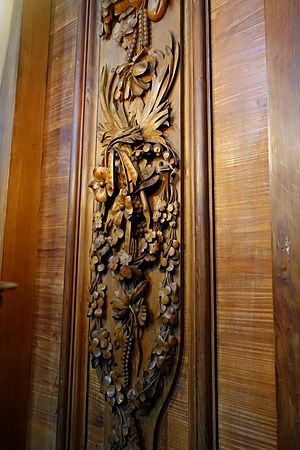Samuel Watson (sculptor) facts for kids

Samuel Watson (1662–1715) was a talented English artist. He was a sculptor who worked with both wood and stone. Samuel was born in a place called Heanor in Derbyshire, England. He spent many years working at a famous house called Chatsworth House, from around 1690 or 1691 until 1711.
Contents
Who Was Samuel Watson?
His Early Life and Training
Samuel Watson was born in Heanor. His father was a farmer, and his mother was Bridget Townsend. Samuel was baptised on December 2, 1662. We don't know much about his very early years.
Later, his grandson, White Watson, wrote some notes about Samuel. He said that Samuel Watson learned his carving skills from a man named Charles Oakey. Oakey was a carver who lived in London.
Learning from the Best Artists
Charles Oakey worked on a big project in 1683. He helped to change and update Badminton House for the Duke of Beaufort. Samuel Watson also worked at other important places. These included Burghley House and Sudbury Hall.
Another very famous carver, Grinling Gibbons, also worked at these same houses. Gibbons had a big impact on Samuel Watson's style. Samuel learned a lot from watching and working near him.
Samuel's Work at Chatsworth House
Samuel Watson started working at Chatsworth House around 1690 or 1691. He quickly became the main carver there. He stayed at Chatsworth for many years, until 1711.
A writer named George Vertue, who lived at the same time, said great things about Samuel's work. He wrote that the wood carvings and decorations by Watson were "very fine." He also called Samuel a "most ingenious artist," meaning very clever and skilled. Many other carvings at Chatsworth are also thought to be Samuel's work.
Samuel Watson's Family Life
Later in his life, Samuel Watson married Katherine Greensmith. She was from a village near Chatsworth called Pilsley. Samuel retired from his work and they moved to Heanor.
Their first son sadly died in 1711. But they had another son in 1714. Katherine was expecting another baby when Samuel died suddenly from a stroke. He was buried in Heanor on March 31, 1715.
A Family of Carvers
Samuel's sons, Henry and Samuel II, both became carvers, just like their father. His grandson, White Watson, also learned to carve. White Watson even designed a special monument for his grandfather in Heanor Church.

